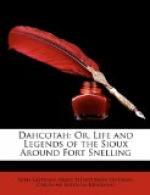Little is generally known of their religion or their customs. One must live among them to induce them to impart any information concerning their mode of life or religious faith; to a stranger they are always reserved.
Their dances and feasts are not amusements. They all have an object and meaning, and are celebrated year after year, under a belief that neglect will be punished by the Great Spirit by means of disease, want, or the attacks of enemies. All their fear of punishment is confined to what they may suffer in this world. They have no fear of the anger of their deities being continued after death. Revolting as the ceremony of dancing round a scalp seems to us, an Indian believes it to be a sacred duty to celebrate it. The dancing part is performed by the old and young squaws. The medicine men sing, beat the drum, rattle the gourd, and use such other instruments as they contrive. Anything is considered a musical instrument that will assist in creating discordant sound. One of these is a bone with notches on it, one end of which rests on a tin pan, the other being held in the left hand, while, with a piece of bone in the right, which a medicine man draws over the notches, sounds as discordant and grating as possible are created.
The squaws dance around the scalps in concentric circles, in groups of from four to twelve together, pressing their shoulders against each other, and at every stroke of the drum raising themselves to their utmost height, hopping and sliding a short distance to the left, singing all the time with the medicine men. They keep time perfectly. In the centre, the scalps are attached to a pole stuck in the ground, or else carried on the shoulders of some of the squaws. The scalp is stretched on a hoop, and the pole to which it is attached is several feet long. It is also covered with vermilion or red earth, and ornamented with feathers, ribbons, beads, and other trinkets, and usually a pair of scissors or a comb. After dancing for a few minutes, the squaws stop to rest. During this interval one of the squaws, who has had a son, husband, or brother killed by a warrior of the tribe from which the scalp she holds was taken, will relate the particulars of his death, and wind up by saying, “Whose scalp have I now on my shoulders?” At this moment there is a general shout, and the dance again commences. This ceremony continues sometimes, at intervals, for months; usually during the warm weather. After the dance is done, the scalp is buried or put up on the scaffold with some of the deceased of the tribe who took the scalp. So much for the scalp dance—a high religious ceremony, not, as some suppose, a mere amusement.




